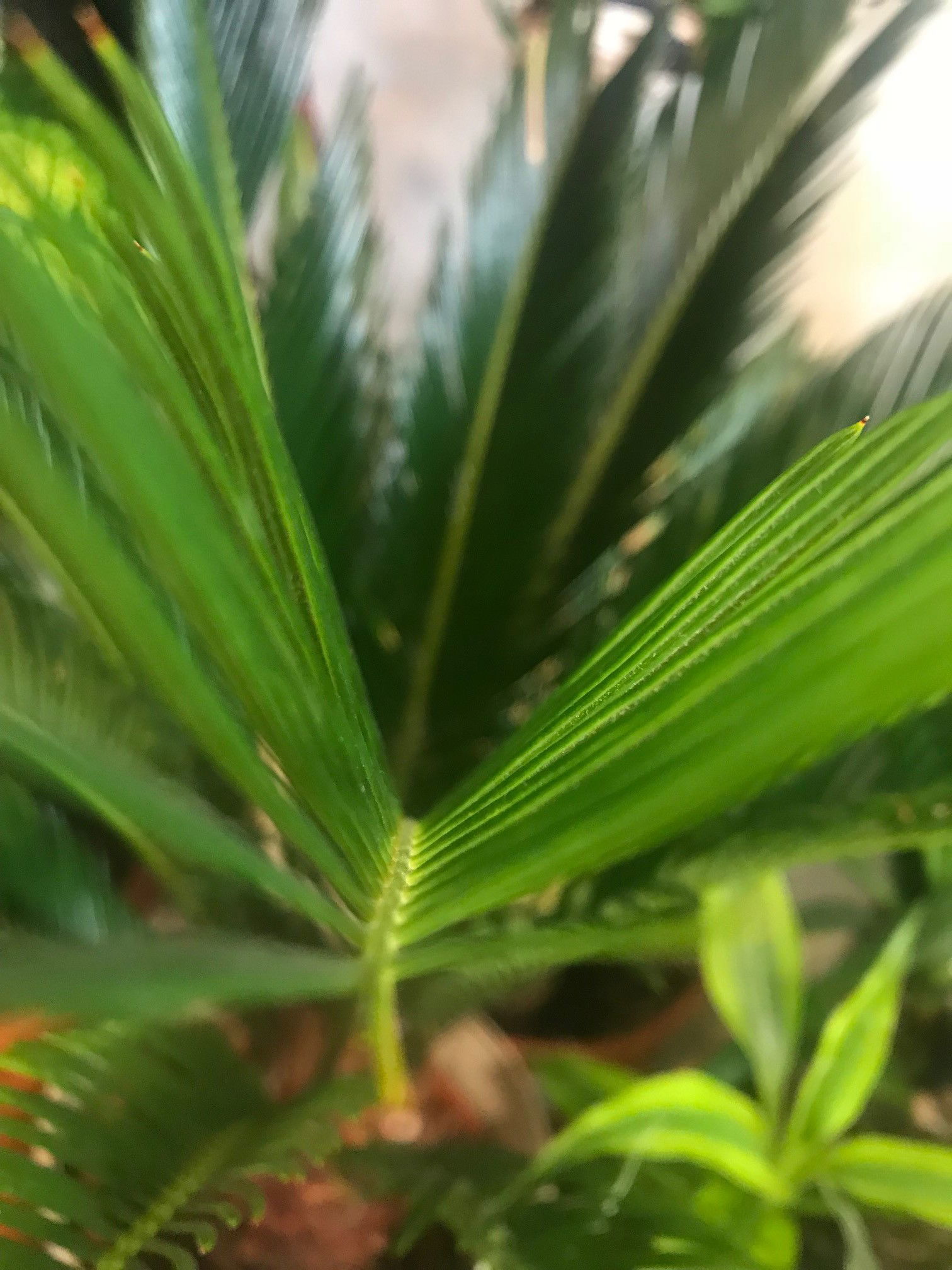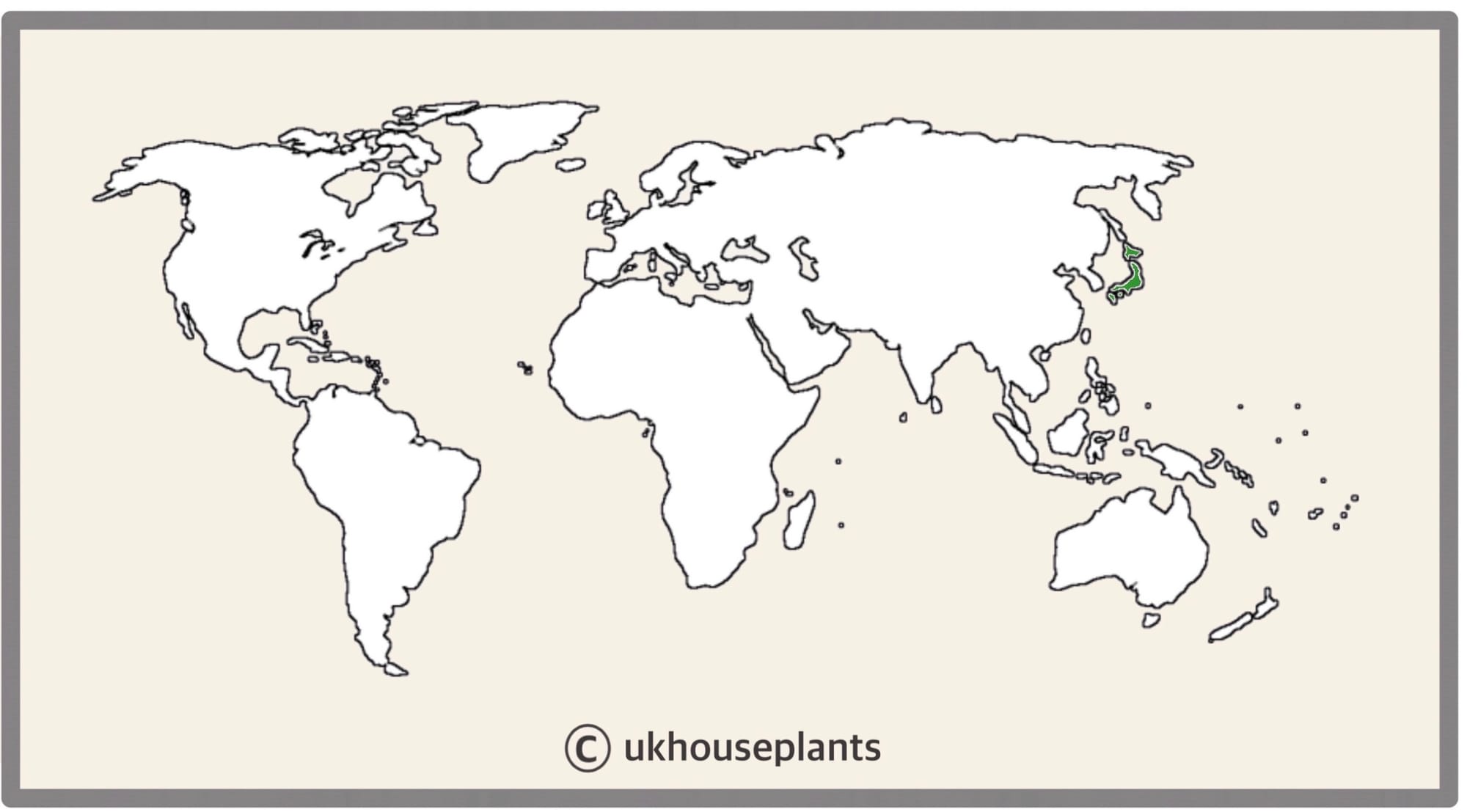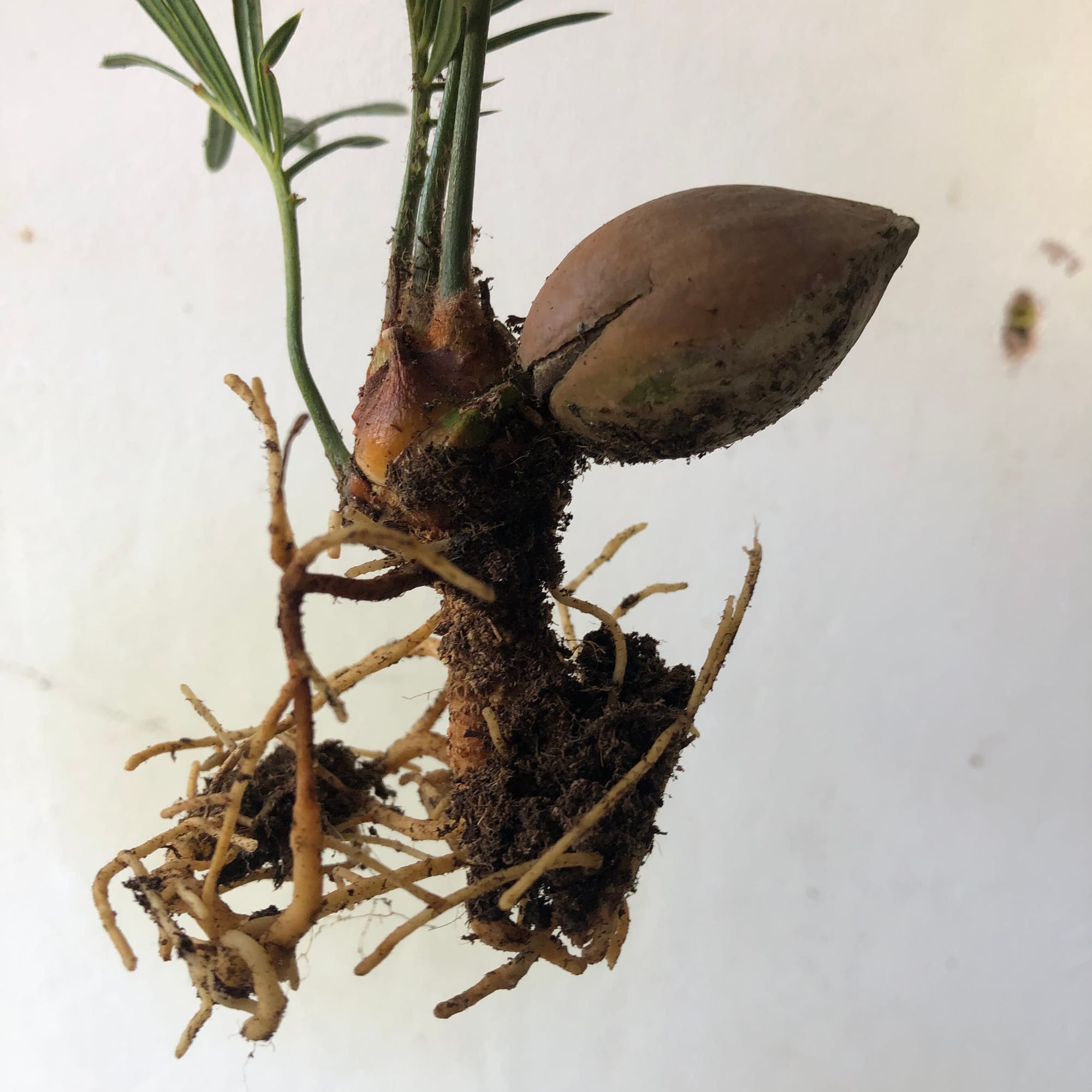
Cycas revoluta
Contents
- Top Tips
- Location, Water, Humidity & Fertilisation
- Common Issues
- Origins, Temperature, Propagation, Repotting & Toxicity.
Need the answer to a specific plant query? Book a 1-to-1 video call with THE HOUSEPLANT DOCTOR™, the website's friendly author, to overcome and address your niggling problem! Available on iMessage, WhatsApp, Facebook Messenger & more.
Top Tips & Info
- Care Difficulty - Easy
- Provide a bright location with a few hours of sunlight - especially in the winter months when the daylight hours are reduced. Never situate a Sago Palm in a shady setting.
- Water once half of the soil dries out, reducing this further in the autumn and winter.
- Introduce a humidity/pebble tray to keep the surrounding moisture high whilst the heaters are operating - the use of artificial humidity is not needed in the summer.
- Fertilise using a 'Houseplant' or 'Cactus' labelled feed every four waters in the spring and summer, reducing this to every six in the colder months.
- Repot every two years using a 'Cactus & Succulent' potting mix and the next sized pot with drainage holes.
Location & Light - 🔸🔸🔸
A few hours of direct sunlight per day is mandatory for quality growth. Darker locations shouldn't be considered unless wholly necessary due to the heightened chance of over-watering related diseases such as Phytophthora root rot. The ideal area within a household is in a semi-shaded conservatory or within three metres of a window.
Water - 🔸🔸
Once half of the soil dries out, give the plant a good drench, reducing this further during the autumn and winter to replicate its dormancy period. Using rainwater is best, but if tap water is the only option, be sure to allow it to stand for at least 24hrs to eliminate the high levels of fluoride. Under-watering symptoms include pale or yellow leaves, stunted growth and gradual decline - these are quite rare due to the genus' ability to endure extended periods of droughts. Over-watering can cause root rot, yellowing leaves and a mushy stem; although this is more common with those grown in darker locations, this could happen at any given time if it's allowed to sit in soggy soil.
Humidity - 🔸🔸
Whilst the heaters are operating, situate the plant on a pebble/humidity tray to combat the dry air. The use of artificial humidifiers aren't needed in the late spring and summer months. Gently hose the foliage down from time to time to hydrate its leaves and wash away dust and potential pests.
Fertilisation - 🔸
Feed every four waters during the growing period and every six in the autumn and winter, using a 'Houseplant' or 'Cactus' labelled fertiliser. Never apply a 'ready to use’ product into the soil without a pre-water first, as it may burn the roots and lead to yellowed leaves.
Common Issues with Sago Palms
Curled leaves and dried brown edges are the result of too little water and over-exposure to the sun. Although Sago Palms can naturally do well in sun-filled locations, those that haven't acclimatised to the harsh rays will show signs of sun-scorch and environmental shock. Gradually increase the amount of light every few days, starting from an indirect location to a few hours of morning/evening sun over a few weeks. Prolonged exposure will significantly speed the process of dehydration, so consider transplantation into a bigger pot in the spring to wrap the roots around moister soil.
Root rot is a common issue with specimens sat in too moist or waterlogged soil for long periods. Symptoms include rapidly yellowing leaves, stunted growth and a rotten brown base. Take the plant out of the pot and inspect health below the soil line. If the roots sport a yellow tinge, you're good to go, but if they're brown and mushy, action must be taken immediately. More information about addressing root rot can be found on this link.
Yellow central leaves are the result of excess moisture settling on the inner sides of the foliage, typically promoted by dark locations. Instead of pouring water directly onto the foliage, irrigate at the soil line by lifting the foliage at the side to prevent saturating the leaves.
Correcting the amount of light is essential for a Sago Palm's health. Locations that are too dark will cause yellowed central leaves, whereas areas that offer intense direct light will easily scorch the leaves and permanently damage the individual leaflets. As mentioned above, a few hours of direct sunlight is very beneficial for the plant, but make sure not to let it endure too much light as this could cause greying or curling of the foliage!
Dust the leaves regularly. Although this isn't too much of an issue, a build-up of dust particles can clog up the plant's pores, causing lowered light capturing-efficiency. Wipe the topsides of the leaves down once a month to keep levels down and improve growing conditions.
Mould developing on the soil means two things - too little light and over-watering. Despite the harmlessness of the mould, it'll prove unsightly to most gardeners and is therefore removed once known. To remove, replace the top two inches of the soil for a fresh batch of 'Cactus & Succulent' compost. Either increase the amount of light received (no direct sunlight for the first few weeks to prevent environmental shock) or decrease the frequency of waters slightly. If the mould is accompanied by yellowing lower leaves, you may also have a case of root rot.
Origins
Cycas is a genus that consists of 113 species mostly originating from equatorial regions across Africa, Asia and Australia. Despite it being first described back in the mid 1700s by Carl Linnaeus, the genus is thought to be over 65 million years old. The species, C. revoluta grows naturally in Oriental Asia and received the RHS' Award of Garden Merit back in 2017. The nickname, Sago Palm, refers to its starch aggregates that can be eaten with pancakes and over savoury snacks.
 The Distribution of Sago Palms
The Distribution of Sago Palms
Temperature
5° - 26°C (40° - 78°F) (Recommended cultivation between 10° - 22°C (50° - 71°F)).
H3 (Hardiness Zone 9) - Tolerate to temperatures below freezing. Although it can survive frosts and thin snow, refrain from bringing it indoors overnight if the room temperature is above 5℃ (40℉), as a sudden change in temperature may cause environmental shock with weakened Spring growth and a lack of flowers over the season's course. Instead, either leave it outdoors or in an unheated conservatory, brightly lit garage or a greenhouse until the risk of frost has elapsed.
Spread
Up to 1.5m in height and 1m in width. The ultimate height will take over twenty years, with one or two new fronds being put out per year.
Pruning & Maintenance
Remove yellow or dying leaves, and plant debris to encourage better-growing conditions. While pruning, always use clean scissors or shears to reduce the chance of bacterial and fungal diseases. Never cut through yellowed tissue as this may cause further damage in the likes of diseases or bacterial infections. Remember to make clean incisions as too-damaged wounds may shock the plant, causing weakened growth and a decline in health.
Propagation
Via Seed or Offsets.
 The sowing of Sago Palm seeds is easy and enjoyable for children - it just takes a while! It took five months to germinate and produce those petioles.
The sowing of Sago Palm seeds is easy and enjoyable for children - it just takes a while! It took five months to germinate and produce those petioles.
 This is what you can expect with its first leaf from seed propagation!
This is what you can expect with its first leaf from seed propagation!
Seeds (Easy) - Soak the seeds in lukewarm water for around 24hrs in a dark location, preferably on top of an operating radiator. The best soil to use is a 'Houseplant' labelled potting mix, however, 'Multipurpose' compost with added perlite and sand is just as good. Set the seeds sideways, a third into the soil. Maintain evenly moist soil and allow the excess water to freely drain from the pot's base to prevent water-logged conditions. The ideal location for successful germination is in a bright, indirect setting with temperatures above 18℃ (64℉) with bottom-heat. Keep the pot in a transparent bag to provide a stable level of humidity, along with longer lasting soil moisture. The roots will develop first, and then the first frond which may take up to a nine months, so don't discard any unsuccessful seeds until this threshold has been surpassed. Remove the bag once the seedlings produces its first frond and then split them up into their own 7cm pots, providing an hour or two of direct sunlight per day. Follow the care tips provided at the top of the article.
Basal or Stem Offset Division (Moderate) - Your plant will produce several basal offsets that can be separated once they have a sufficient root system, and surpass 20cm (7.8 inches) in height. If possible, water the soil 24hrs before the main event to reduce the risk of transplant shock, when its dry root systems are over-fingered. Take the plant out of its pot and place your fingers close to the nodal junction - soil may have to be removed for better access. Push the chosen offset downwards until you hear a snap. Separate the foliage and its root system away from the mother plant, mentally noting the high risk of damage. Transplant in the appropriate sized pot with a fresh batch of 'Houseplant' soil. Maintain evenly moist soil and situate it in a bright, indirect location away from any direct sunlight. After twelve weeks, treat it like a normal specimen, following the care tips above!
Flowers
Sago Palms are dioecious, meaning that the flowers are either male or female and needs two opposite sexed plants for pollination. Its flowers are located directly in the centre of the plant and will develop once the plant reaches the maturity of over eight years. The male flowers are shaped like a cone, whereas the females form a shallow shield - both sporting a yellow appearance. It's unfortunately sporadic for an indoor Sago to flower due to the insufficient conditions that are on offer in our homes.
Repotting
Repot every two years in the spring, using a 'Cactus & Succulent' labelled compost and the next sized pot with adequate drainage. Hydrate the plant 24hrs before tinkering with the roots to prevent the risk of transplant shock. For those that are situated in a darker location, add a thin layer of small grit in the pot's base to improve drainage and downplay over-watering. Click here for a detailed step-by-step guide on transplantation, or via this link to learn about repotting with root rot.
Book a 1-to-1 video call with THE HOUSEPLANT DOCTOR™ if you'd like a personal guide to repotting your houseplant. This will include recommending the right branded-compost and pot size, followed by a live video call whilst you transplant the specimen for step-by-step guidance and answer any further questions!
 Telling whether your Sago Palm has healthy roots is easy - just check the root strands and its root-tips! Remember not to pull soil from its roots and instead carefully scan the side of its rootball, as excessive touching may cause Transplant Shock.
Telling whether your Sago Palm has healthy roots is easy - just check the root strands and its root-tips! Remember not to pull soil from its roots and instead carefully scan the side of its rootball, as excessive touching may cause Transplant Shock.
Pests & Diseases
Keep an eye out for mealybugs, spider mites, scale, thrips, whitefly, vine weevils & root mealybugs that'll locate themselves in the cubbyholes and undersides of the leaves, except for the latter two in the soil. Common diseases associated with Cycads are root rot, leaf-spot disease, botrytis, powdery mildew & southern blight - click here to learn more about these issues.
Toxicity
This plant is classified as poisonous, so if small sections are eaten, vomiting, nausea and a loss of appetite may occur. Consumption of large quantities must be dealt with quickly; acquire medical assistance for further information.
Retail Locations
Blue Diamond, Online Stores.
Book a 1-to-1 Call with THE HOUSEPLANT DOCTOR™
If you need further advice with your houseplants, book an advice call with ukhouseplants' friendly and expert writer today! This can be done via a video or audio call on most apps, including Facebook, FaceTime & Skype. A ten-minute call costs £5.99 (US$7), or £15.99 for thirty minutes. You can ask multiple questions, including queries on plants, pests, terrariums, repotting advice and anything in between. Please consider supporting this service to keep ukhouseplants thriving!